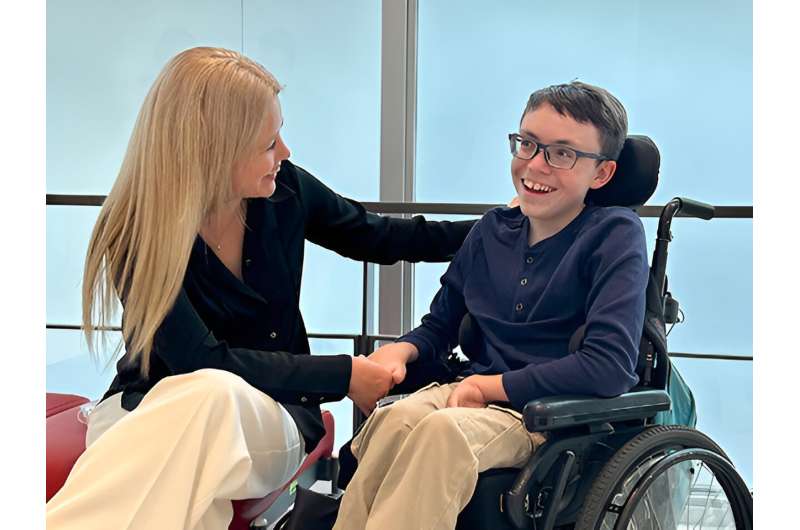This article has been reviewed according to Science X's editorial process and policies. Editors have highlighted the following attributes while ensuring the content's credibility:
fact-checked
peer-reviewed publication
trusted source
proofread
Research team creates first representative animal model of 4H leukodystrophy

A research team led by Dr. Geneviève Bernard at the Research Institute of the McGill University Health Center (RI-MUHC) has reached an important milestone in research into leukodystrophies, which are deadly neurodegenerative diseases that affect approximately one in 4,700 children and remain incurable to this day.
The team has succeeded in creating the first representative animal model of 4H leukodystrophy, one of the common forms of the disease. This is a crucial step in the development of treatments, and was recently described in an article published in the journal Brain.
"This significant progress will allow us to understand the disease better and to test putative therapies, which we have already started doing. Without such a disease model, there would be limited to no hope of finding a cure for this disease," says Dr. Bernard, a scientist in the Child Health and Human Development Program at the RI-MUHC and a neurologist at the Montreal Children's Hospital of the MUHC.
"By developing this model, we've answered fundamental questions about disease pathogenesis. Deep understanding of the biology of a disease is a foundational aspect of therapy development," adds Mack Michell-Robinson, first author of the study and MD-Ph.D. student in Dr. Bernard's lab at the RI-MUHC.
Of genetic origin, leukodystrophies affect the myelin, a kind of "insulating sheath" that surrounds and protects the brain cells or neurons and contributes to cell-to-cell communication. 4H leukodystrophy is the combination of hypomyelination (myelin deficiency leading to motor, balance and coordination problems, as well as a deterioration in children's physical condition) and two other conditions: hypodontia (dental anomalies) and hypogonadotropic hypogonadism (endocrine dysfunction leading to delayed, arrested or absent puberty).
The researchers have succeeded in recreating a POLR3B mutation in a mouse model. POLR3B mutations cause around half of all cases of 4H leukodystrophy. The model displays the main features associated with the disease phenotype, as seen in patients: hypomyelination, hypodontia and craniofacial anomalies.
The culmination of a decade's hard work
Creating such a model to shed light on how mutation affects the body and advance the search for treatments is no easy feat, and Dr. Bernard's efforts to achieve it go back more than a decade.
"It was essential to create a representative model of the disease to develop therapeutic approaches in the laboratory in future preclinical studies," explains Dr. Bernard, who is also associate professor in the Department of Neurology and Neurosurgery, and Pediatrics, at McGill University. "The lab is now working on the development of the first gene replacement therapy approach for the disease."
This achievement would not have been possible without the support of the Yaya Foundation for 4H Leukodystrophy, a U.S.-based nonprofit focused on accelerating discovery of treatments and supporting the 4H leukodystrophy community worldwide, and the Montreal Children's Hospital Foundation.
"The Yaya Foundation was proud to accelerate and support this incredible breakthrough in 4H leukodystrophy disease understanding and grateful for the generosity provided to the Foundation, making it possible to sponsor this work," says Ben Smith, executive director of The Yaya Foundation.
"This discovery is a critical building block in the quest to discover effective treatments for people affected by 4H and demonstrates the advances that are possible when patients, families, and researchers come together to identify the most important problems to solve and find the right people to solve them. This collaboration and the discoveries it has already produced give our community hope that people affected by 4H will one day soon be able to live longer, fuller lives," adds Ron Garber, co-founder and board president of the Yaya Foundation.
"Philanthropy is a powerful tool to fund innovation and we are proud to support Dr. Bernard's research to provide new hope for children suffering from 4H leukodystrophy and their families," says Renée Vézina, president of The Montreal Children's Hospital Foundation.
The importance of tackling rare diseases
Rare diseases are individually rare, but collectively, they affect approximately three million people in Canada and 500,000 in Quebec. Like 4H leukodystrophy, they are often progressive, affect most commonly children, impact multiple body systems, have limited to no treatment options and require complex medical and personal care. It is therefore essential to understand rare diseases better and to develop novel therapies, and 4H leukodystrophy is no exception.
"Although this is a rare disease, the burden on patients, families and the health care system are enormous. Therefore, understanding disease pathogenesis to develop new treatments is imperative," emphasizes Dr. Bernard.
A physician devoted to her patients and their families, Dr. Bernard is recognized internationally as a leading specialist in leukodystrophies. During her postdoctoral studies under Dr. Bernard Brais, she discovered the first gene responsible for the disease. Her laboratory at the RI-MUHC subsequently paved the way for important discoveries in the description of leukodystrophies, the identification of new causal genes, the understanding of disease pathogenesis and the development of therapies.
The MUHC, recently recognized as an Interdisciplinary reference center for care and research in rare diseases, is proud of the variety and high quality of the expertise it brings together in this field, whether in diagnostics, patient care or fundamental and clinical research. It is also grateful to the public, private and philanthropic organizations that make these activities possible, for the benefit of sick children and adults.
More information: Mackenzie A Michell-Robinson et al, Hypomyelination, hypodontia and craniofacial abnormalities in a Polr3b mouse model of leukodystrophy, Brain (2023). DOI: 10.1093/brain/awad249




















